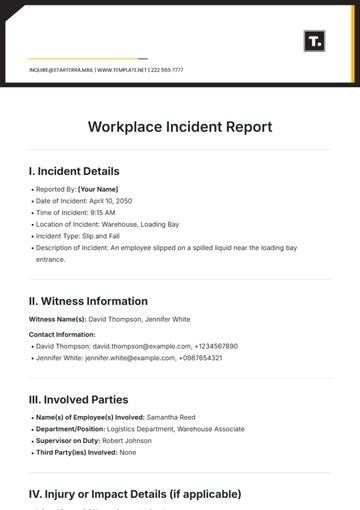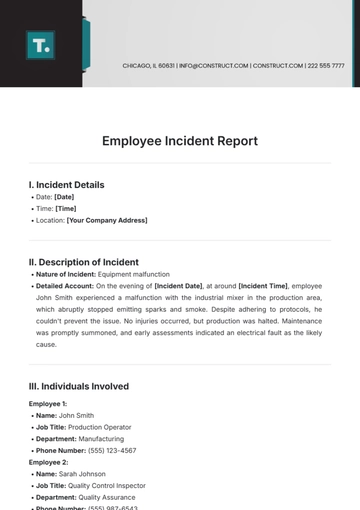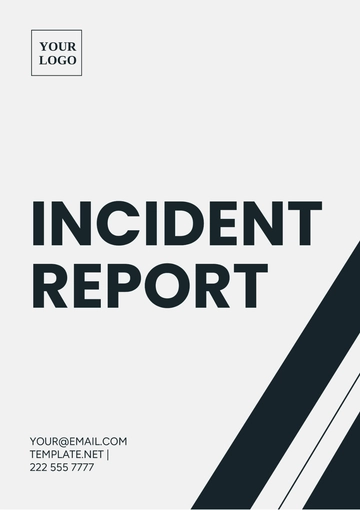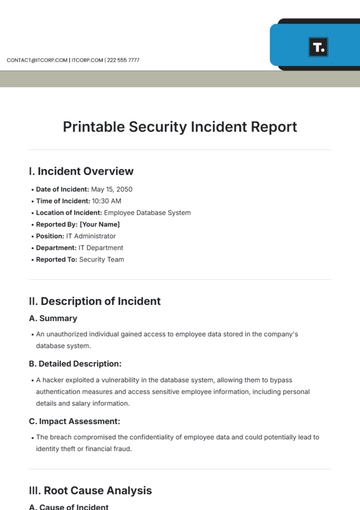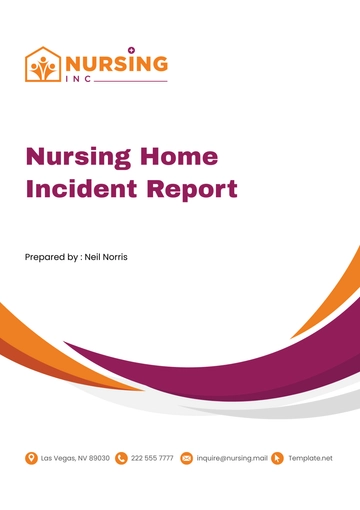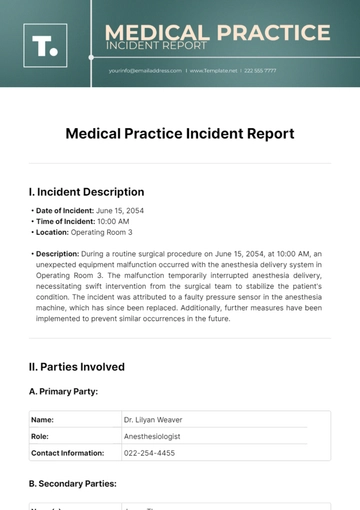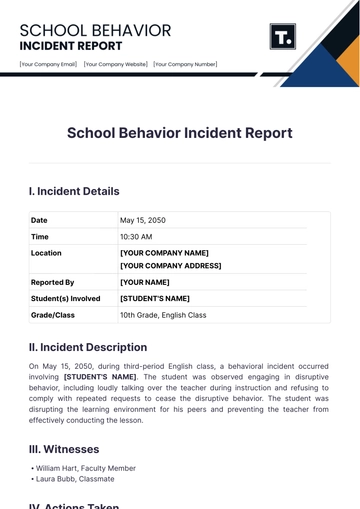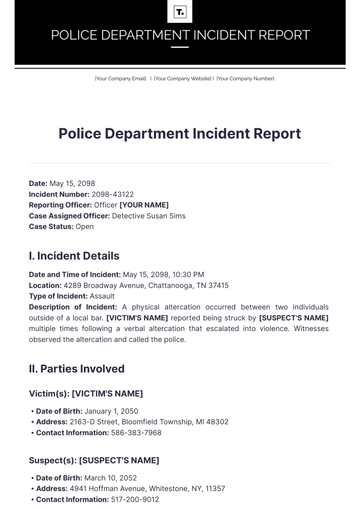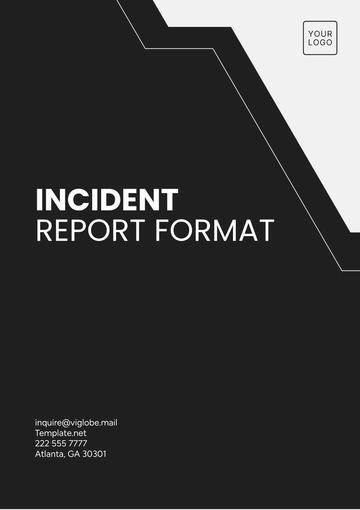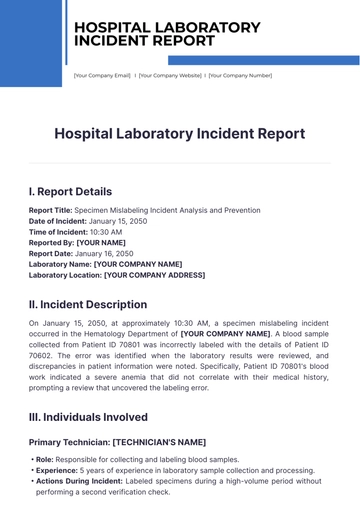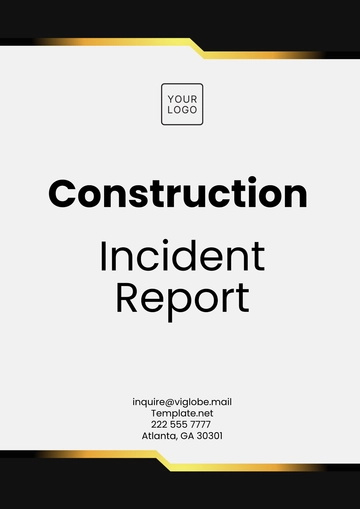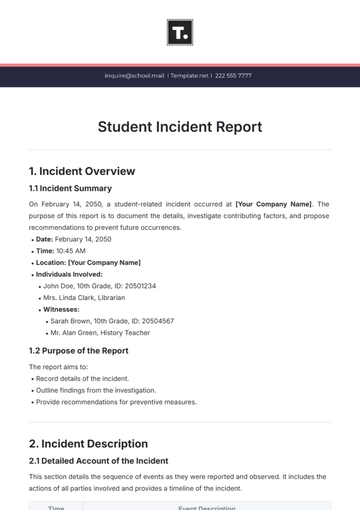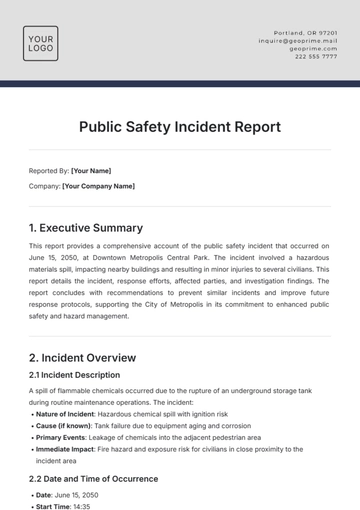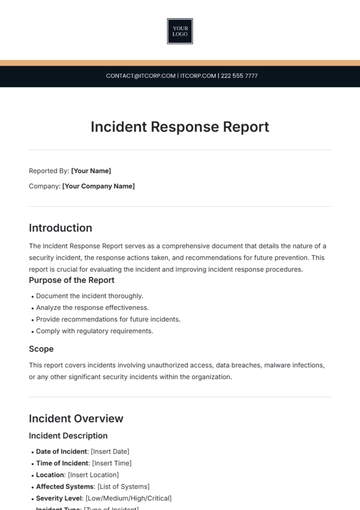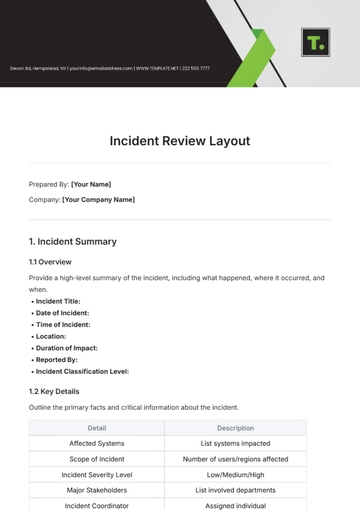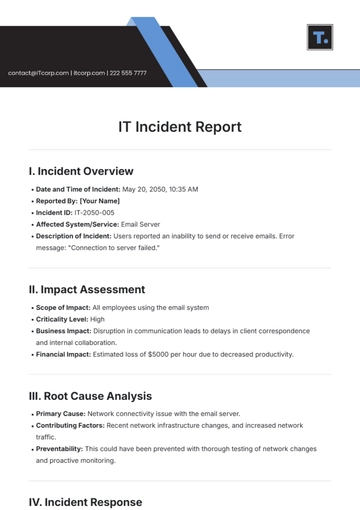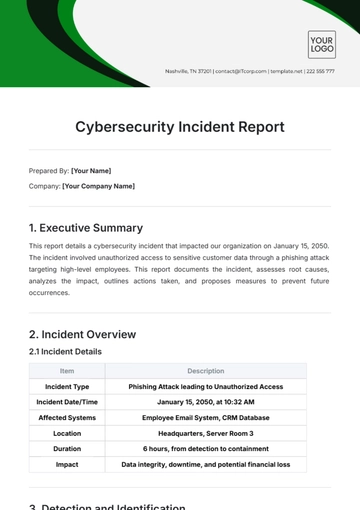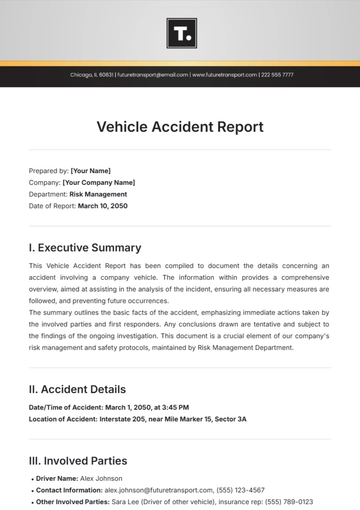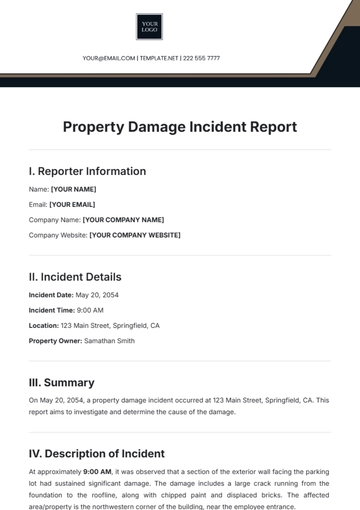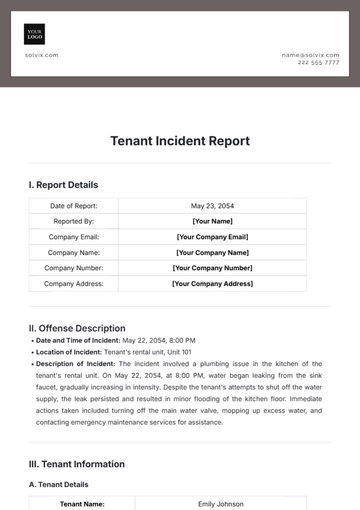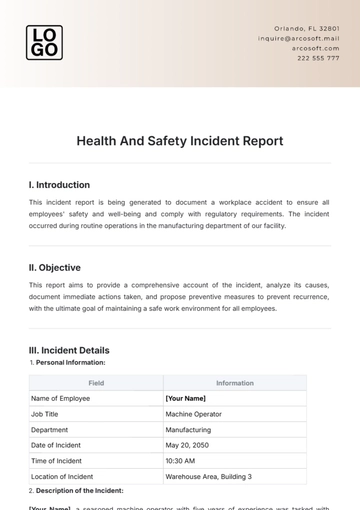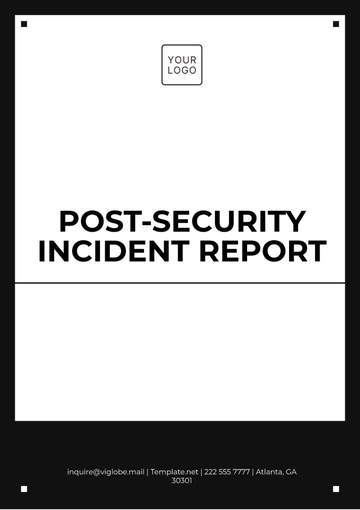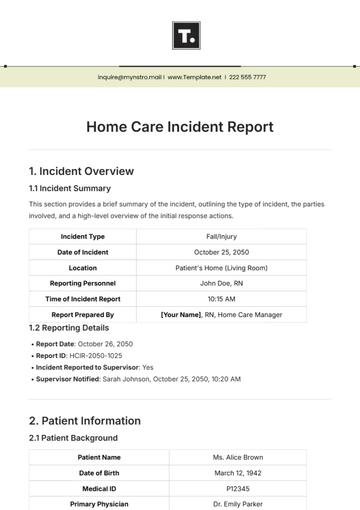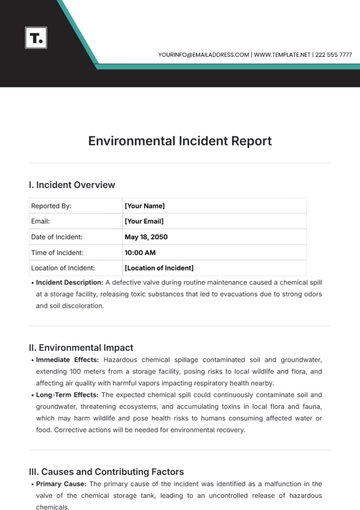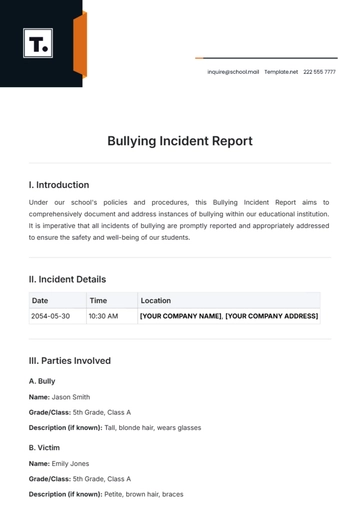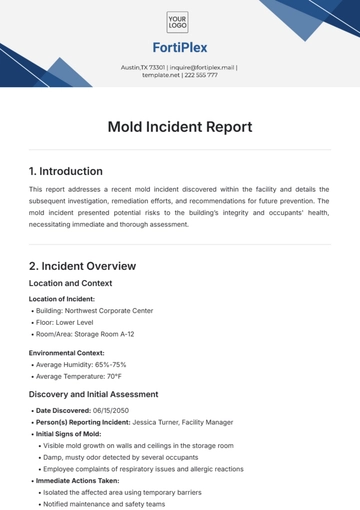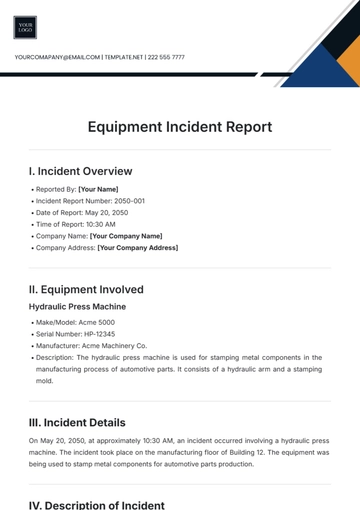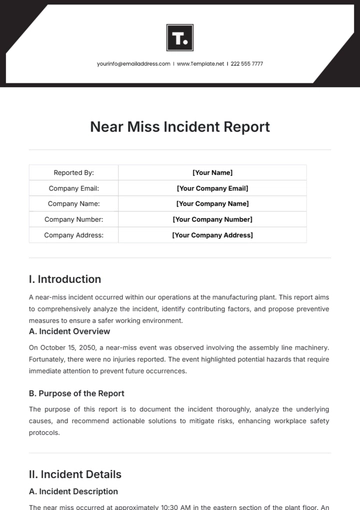Free Nursing Home Student Incident Report
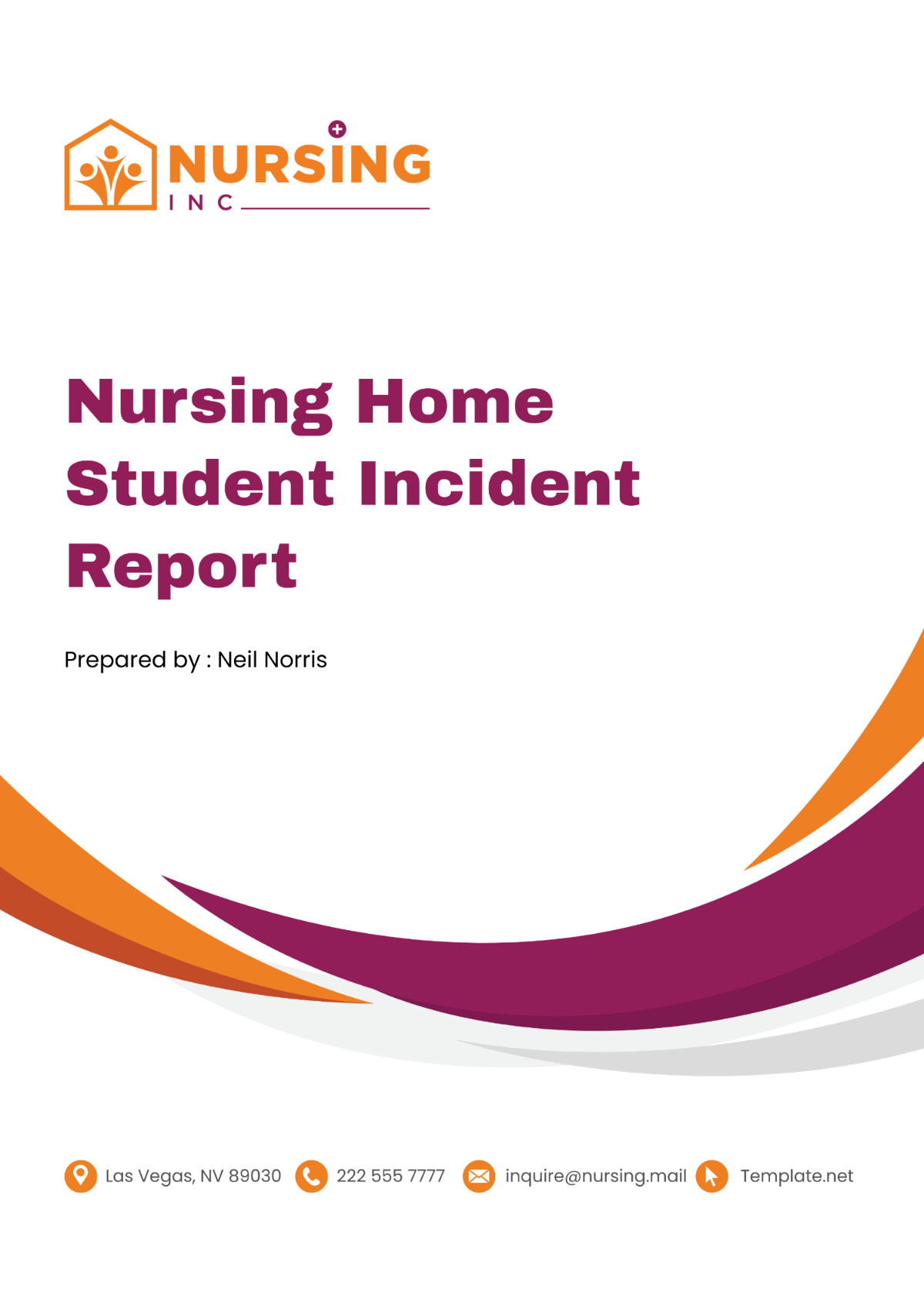
I. Incident Details
A. Date and Time of Incident
The incident took place on a specific day, detailed as [Date]. This occurrence precisely unfolded at a particular instant, recorded as [Time]. The event happened during the usual morning shift at the facility. The specific location of this incident was the West Wing of the said facility, explicitly identified as Room 203A. The mentioned time was deliberately selected to coincide perfectly with the planned morning activities of the resident within the facility. These activities comprise of various tasks, ranging from personal care to assistance with movement and mobility.
B. Location
The particular incident we are referring to unfolded within the confines of the resident's room. This room was adequately provided for, equipped with an assortment of standard furnishings. It included a hospital bed, primarily for the resident’s comfort and care, a wheelchair for mobility purposes, and a bedside table for convenience and storage. This room, numbered 203A, is strategically situated on the second floor of the nursing home facility. More specifically, it is a part of the West Wing of the nursing center. One key feature of its location includes being in close proximity to the nursing station. This is so there is quick and easy access to assistance from the nursing staff whenever such assistance is required.
C. Incident Type
The incident that has taken place is being identified under the category of a student injury. This is due to it having transpired as a result of a student falling whilst they were involved in activities related to patient care. According to the instituted protocol for reporting incidents within this facility, this particular instance has been classified as a Level 2 incident. This particular classification signifies that the severity of the incident is considered to be at a moderate level.
D. Description of Incident
While assisting a resident with mobility impairment in transferring to a wheelchair, the student, [Student's Name], inadvertently lost her balance and fell, resulting in a laceration to her forearm. The incident occurred due to a miscommunication between the student and the supervising nurse, [Nursing Staff's Name], regarding the resident's mobility status and the appropriate transfer technique.
II. Individuals Involved
A. Student Information
The student at the center of this situation is [Student's Name]. She is currently enrolled in her second year at the Community College of Nursing, pursuing a degree in nursing. As part of her studies and in efforts to provide practical, hands-on experience, she had been assigned to a local nursing home. The nursing home assignment was part of [Student's Name]'s clinical rotation, a component of her program designed to expose students to real-world scenarios in patient care and to develop essential skills such as basic patient care.
Aside from academic studies, [Student's Name]’s education has encompassed various practical courses such as building competencies in mobility assistance techniques, which are integral to the role of a nurse. This combination of classroom learning and field experience is meant to prepare [Student's Name] for her future career in nursing.
B. Nursing Home Staff Involved
During the incident in question, the person responsible for supervising the nursing students and coordinating patient care activities in the facility's West Wing, was an experienced registered nurse (RN) going by the name of [Nursing Staff's Name]. She was serving as the charge nurse, a role that places her in a position of authority and accountability for tasks under her supervision. Her experience is not only expansive but also includes five years of employment in this nursing home.
Throughout this period, [Nursing Staff's Name] has proven her proficiency in geriatric nursing care, bolstering her hands-on experience year by year. Therefore, [Nursing Staff's Name] can be considered a highly experienced registered nurse, particularly well-versed in the care of elderly patients, affirming her suitability for her appointed role during the incident.
C. Witness Information
Witness 1:
The incident in question was witnessed by [Witness' Name], who is a certified nursing assistant, also known as a CNA, employed in the same unit as the one where the incident occurred. According to his report, he specifically noted a moment of confusion that arose between the student and the nurse who was supervising them in regards to the correct method of transferring the resident in an appropriate manner.
It’s important to note that [Witness' Name] has been working at this nursing facility for a span of three years and during this time, he has gained a thorough understanding of the standard procedures that need to be followed when caring for patients.
IV. Injury Assessment
A. Student Injury
On the occasion of her unfortunate fall, [Student's Name], suffered from a minor yet noticeable laceration on her forearm. Subsequent to the incident, a thorough assessment of the injury was conducted. The evaluation confirmed that, fortunately, the injury was superficial in nature and presented no signs of potential damage to the underlying tissues. In the immediate aftermath of the incident, Charge Nurse [Nursing Staff's Name] was quick to act. Collaborating proficiently and swiftly, [Nursing Staff's Name] administered the necessary first aid measures to treat [Student's Name]'s laceration. These measures included the careful cleansing of the injury site, following which an appropriate dressing was applied to the laceration on the young woman's forearm. Subsequent to this precise and immediate care taken, [Student's Name] was advised to seek further medical evaluation if any complications or concerns arose concerning her laceration.
Even in the face of the potentially distressing circumstance, [Student's Name] demonstrated considerable resilience. Despite reporting a mild ache originating from the site of her injury, the student showed no signs of severe discomfort or incapacitation. Furthermore, she displayed an impressive range of motion in her fingers and wrist. This significant detail suggested that her nerves and muscles functioned properly, despite the physical trauma she had recently undergone.
V. Immediate Actions Taken
A. First Aid Provided
As soon as Charge Nurse [Nursing Staff's Name] found out about [Student's Name]'s injury, she wasted no time in responding to the situation. Her immediate reaction was to provide first aid. This included applying pressure on the laceration site to mitigate any ongoing bleeding. Once that was under control, she proceeded with the further stage of cleaning and sterilizing the wound using an antiseptic solution.
The next step she took was to apply a sterile dressing to the cleaned wound. She used adhesive tape to secure this dressing firmly in place, ensuring that it could adequately protect the wound against any potential further contamination. Right throughout this process, [Student's Name] was constantly reassured and given every encouragement by the nurse to stay calm and composed.
B. Notification of Authorities
[Nursing Staff's Name] administered first aid, and without delay, proceeded to notify both the nursing home's management team and the clinical coordinator of the educational institution that the incident had taken place. The method of notification employed was two-pronged - a phone call and an email - to ensure that communication was not only swift, but also reliable.
Post this, [Nursing Staff's Name] meticulously recorded the details of the incident into the nursing home's electronically managed health record system, strictly adhering to the protocol established by the facility. This vigilant documentation is a part of the standard response to any such incident at the facility.
C. Documentation
An incident report with comprehensive details was immediately noted down in the electronic health record system that the nursing home facilitates. The detailed report meticulously documented all the factors associated with the particular incident. It took into account the specific circumstances that led to the incident. It clearly delineated the extent of the injury that was suffered by the student whose name was mentioned in the report. Besides, it also included a detailed account of all the actions that the nursing staff undertook in response to the incident.
This entire process of documentation was not only undertaken for the mere necessity of record keeping. Instead, it was developed with an aim to create an exhaustive record of the event. This record could be referred to in the future for any needs of analysis or reference. In addition to documenting the incident, the electronic health record of the student, who was named in the report, was promptly updated. This update incorporated the details of the injury that the student had suffered as a result of the incident. Furthermore, it also included a description of the treatment administered by the medical staff in response to the injury.
VI. Follow-Up Actions
A. Investigation
An investigation was initiated by the nursing home's quality assurance team to determine the root cause of the incident. This investigation involved interviewing all parties involved, reviewing relevant policies and procedures, and examining any contributing factors such as staffing levels and training protocols. The goal of the investigation was to identify areas for improvement in patient care practices and staff training to prevent similar incidents in the future.
B. Corrective Measures
As a result of the investigation findings, several corrective measures were implemented to prevent similar incidents from occurring. These measures included conducting additional training sessions for nursing students and staff on safe patient handling and transfer techniques, emphasizing the importance of clear communication and teamwork during patient care activities, and reinforcing adherence to established protocols and procedures. Additionally, regular audits and assessments of patient care practices were scheduled to ensure ongoing compliance and quality improvement.
C. Communication
The findings of the incident investigation and the implemented corrective measures were communicated to all nursing staff and students through staff meetings, email notifications, and in-service training sessions. This communication emphasized the importance of learning from incidents to improve patient safety and quality of care. Additionally, ongoing monitoring and feedback mechanisms were established to track the effectiveness of the corrective measures and address any emerging issues proactively.
VII. Additional Comments/Notes
No additional comments or notes were recorded at the time of completing this incident report. However, ongoing monitoring and follow-up will be conducted to assess [Student's Name]'s recovery progress and to ensure that the implemented corrective measures remain effective in preventing similar incidents.
VIII. Signature and Date
The incident report has been prepared diligently to document the details surrounding the unfortunate incident involving [Student's Name], a nursing student, on [Date]. We have taken every measure to ensure accuracy and thoroughness in our documentation, adhering to established protocols and procedures. The following signatures indicate our commitment to transparency, accountability, and ongoing improvement in patient care practices.
Prepared By

[Nursing Staff's Name],
RN (Charge Nurse)
[Date]
Reviewed By

[Signature]
[Position/Title]
[Date]
- 100% Customizable, free editor
- Access 1 Million+ Templates, photo’s & graphics
- Download or share as a template
- Click and replace photos, graphics, text, backgrounds
- Resize, crop, AI write & more
- Access advanced editor
Provided by Template.net, our Nursing Home Student Incident Report Template is an editable and customizable tool designed to streamline incident documentation processes. This comprehensive template facilitates efficient reporting of student-related incidents in nursing home settings. With user-friendly features and compatibility with AI Editor Tool, ensure accurate and professional incident reports with ease.
You may also like
- Sales Report
- Daily Report
- Project Report
- Business Report
- Weekly Report
- Incident Report
- Annual Report
- Report Layout
- Report Design
- Progress Report
- Marketing Report
- Company Report
- Monthly Report
- Audit Report
- Status Report
- School Report
- Reports Hr
- Management Report
- Project Status Report
- Handover Report
- Health And Safety Report
- Restaurant Report
- Construction Report
- Research Report
- Evaluation Report
- Investigation Report
- Employee Report
- Advertising Report
- Weekly Status Report
- Project Management Report
- Finance Report
- Service Report
- Technical Report
- Meeting Report
- Quarterly Report
- Inspection Report
- Medical Report
- Test Report
- Summary Report
- Inventory Report
- Valuation Report
- Operations Report
- Payroll Report
- Training Report
- Job Report
- Case Report
- Performance Report
- Board Report
- Internal Audit Report
- Student Report
- Monthly Management Report
- Small Business Report
- Accident Report
- Call Center Report
- Activity Report
- IT and Software Report
- Internship Report
- Visit Report
- Product Report
- Book Report
- Property Report
- Recruitment Report
- University Report
- Event Report
- SEO Report
- Conference Report
- Narrative Report
- Nursing Home Report
- Preschool Report
- Call Report
- Customer Report
- Employee Incident Report
- Accomplishment Report
- Social Media Report
- Work From Home Report
- Security Report
- Damage Report
- Quality Report
- Internal Report
- Nurse Report
- Real Estate Report
- Hotel Report
- Equipment Report
- Credit Report
- Field Report
- Non Profit Report
- Maintenance Report
- News Report
- Survey Report
- Executive Report
- Law Firm Report
- Advertising Agency Report
- Interior Design Report
- Travel Agency Report
- Stock Report
- Salon Report
- Bug Report
- Workplace Report
- Action Report
- Investor Report
- Cleaning Services Report
- Consulting Report
- Freelancer Report
- Site Visit Report
- Trip Report
- Classroom Observation Report
- Vehicle Report
- Final Report
- Software Report
